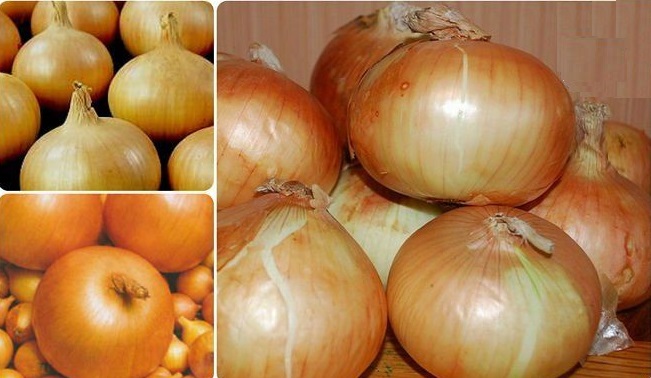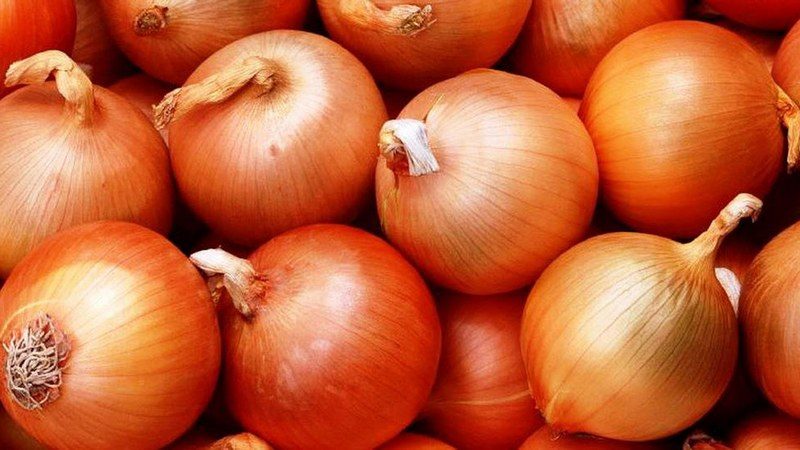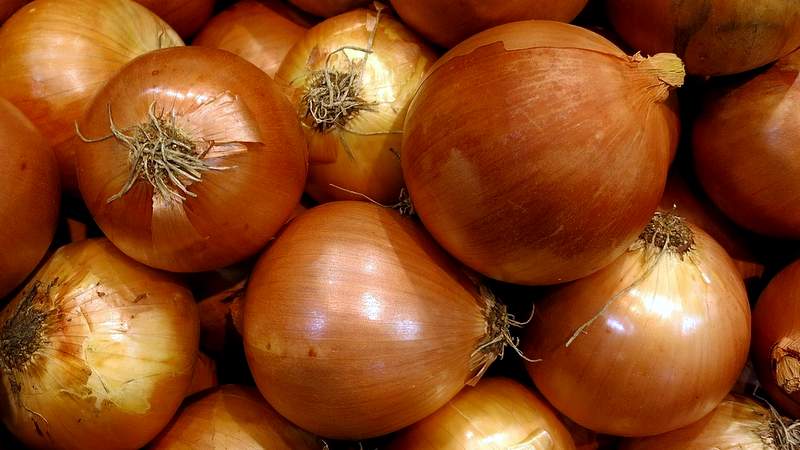Very early and cold-resistant salad type of onion "Ellan"
The onion variety Ellan conquered gardeners with its ultra-early ripening and semi-sharp taste. It is planted not only in spring, but also before winter for a quick harvest. The culture is resistant to light frost, the bulbs themselves are rich in ascorbic acid.
The content of the article
Description
Ellan is a salad variety. It is grown before winter by planting seeds in the summer or sevka in the fall.
Origin and development
Ellan is from the Kuban. It was entered into the State Register of Breeding Achievements of the Russian Federation in 1997.
The originator of the variety is FGBOU VO “Kuban State Agrarian University named after IT Trubilin”.

Composition and useful properties
The onion is rich vitamins and minerals.
Chemical composition per 100 g:
- calcium - 31 mg;
- phosphorus - 58 mg;
- magnesium - 14 mg;
- potassium - 148 mg;
- silicon - 5 mg;
- sulfur - 70 mg;
- iron - 0.8 mg;
- zinc - 0.85 mg;
- boron - 200 mcg;
- cobalt - 5 mcg.
Vitamins per 100 g:
- B1 - 0.048 mg;
- B2 - 0.019 mg;
- B5 - 0.1 mg;
- B6 - 0.2 mg;
- B9 - 53 mcg;
- C - 12.5 mg;
- PP - 0.52 mg;
- E - 0.2 mg.
Nutritional value per 100 g:
- calorie content - 41 kcal;
- proteins - 1.7 g;
- fats - 0.2 g;
- carbohydrates - 8.2 g;
- water - 86 g;
- dietary fiber - 2 g.
The vegetable is useful for eating raw, as it contains a large amount of macro-, microelements and vitamins. It has antiseptic, tonic, antioxidant properties. Normalizes the work of the endocrine, immune and nervous systems.
Ripening period and yield
Ellan's growing season is 64–99 days when grown from seedlings.
The marketable yield of turnip in the North Caucasian region is 100–250 c / ha. Up to 2.5 kg of onions are harvested from 1 m2.
Disease resistance

The variety is immune to yellow dwarfism and mosaic. It is slightly affected by peronosporosis. When grown in too moist soil, prone to powdery mildew, gray mold and rust.
Specifications
The main qualities of Ellan bulbs:
- the shape is round or slightly flattened;
- the pulp is white;
- weight - 64–123 g;
- the number of yellow dry scales - 2-3;
- the taste is sweet, slightly pungent.
The rosette of leaves is dense. Plant height - up to 30 cm. Greens during the growth period stand upright and practically do not lodge. Feathers are dark green with a waxy coating, medium diameter.
Landing regions
The variety is recommended for cultivation in the North Caucasus. These include the Republics of Adygea and Chechen, Ingushetia, Dagestan, Crimea, North Ossetia - Alania, Kabardino-Balkarian, Krasnodar Territories and Rostov Oblast.
Advantages and disadvantages

Ellan's positive characteristics:
- early maturation;
- aligned shape of the bulbs;
- frost resistance of seeds and seedlings (they sprout even at + 1 ... + 2 ° C);
- good taste;
- high ripening (before harvesting - 82%, after ripening - 96-100%).
Lack of variety - short term storage... Vegetables quickly begin to deteriorate and dry out.
The main difference between Ellan and other varieties is early ripening. Winter onions are harvested already in June - July, when last year's vegetables run out, and new ones have not yet grown.
Features of planting and growing
Elan onions grown by seed or sevkom.Planting is carried out both in early spring and before winter.
Training
Elan onion seeds are obtained independently or bought in a store. In the first case, arrows with round balls on which the seeds are located are waiting. When the arrow begins to dry and the seeds turn black, they are collected for further processing and storage.
The planting material is poured with water and left for an hour. Full large specimens will settle to the bottom, and dry ones will float. They are thrown out. The rest of the seeds are disinfected in a solution of potassium permanganate and hardened. To do this, the bag with grains is first placed in hot water at a temperature of + 60 ° C, and then in cold water. Seeds are planted in open ground in spring. The garden is prepared in the fall.
When growing onions, the smallest specimens with a diameter of up to 2 cm are selected from the set. The larger ones are left on the feather, since they are strongly pointed.
It is important to observe crop rotation. Onions are planted where legumes, cabbage, potatoes, or crops other than oats used to grow.
Bad predecessors:
- garlic;
- carrot;
- onion.
Ground requirements
For planting Ellan, a bed with nutritious soil is prepared. The acidity of the soil should not be higher than 7 pH. If the soil is high in clay, its acidity will be overestimated. To reduce the rate, 7-14 days before landing lime or dolomite flour is added to the soil.
By the way! The pH level is measured with special strips that are sold in hardware stores.
The soil should not be dense so as not to obstruct the outflow of water after irrigation or rain. Therefore, the site is chosen at a slight slope. A little sand or peat is added to the ground.
For better development of the culture, when planting, 3-5 kg / m² of humus and any phosphorus-potassium fertilizer are applied.
Timing, scheme and landing rules
Growing from seeds begins in early spring, when the soil warms up to at least + 1 ° C. Most often - in March - April.
Seeds are planted between rows. To do this, they dig up a plot and form small trenches, leaving 15–20 cm between them. Rotted manure is placed on the bottom. Planting early this is especially good as it will serve as a source of heat. 1.5 g of seeds are planted on 1 m² of the plot, seeding them to a depth of about 2 cm.
Podzimny planting sevka is carried out in October or November in the still not frozen soil, 3 weeks before stable frosts. Spring sowing is carried out in April, but the harvest is obtained a month later.
Sevok is planted in rows, leaving 10-15 cm between them, between the bulbs - 1.5-2 cm.
The nuances of care
Onion seeds have a hard shell and do not germinate well at low temperatures. Therefore, it is good to plant them in the ground already germinated.
The variety is frost-resistant and feels good with a short drop in temperature to -4 ° C.
When growing a culture on a feather, the temperature should be within + 20 ... + 25 ° C.
It is important to follow all the recommendations for watering, weeding and fertilizing plantings.
Watering mode
Highlights:
- moisten the planting only if the earth is dry;
- pour water carefully into the root zone;
- do not water areas where there are no onions, so as not to promote the growth of weeds;
- to regulate humidity, mulch the beds.
Sprinkle plants with water at room temperature. Too cold liquid will harm plantings and provoke the appearance of diseases.
Frequency of humidification - at least once every 7 days. During the growing season, about 9-10 waterings will be obtained.
Loosening and weeding
After moistening, the soil is compacted and a crust forms, which prevents oxygen from reaching the roots. To prevent this from happening, the next day after rain or watering, the ground is loosened with a garden hoe or other tool. Movements are directed away from the onion to make room for the further development of vegetables.
To prevent the weeds from taking nutrients from the soil, the beds are weeded in time. When the onion sprouts are still small, remove the weeds by hand.
Important! To weed the beds less often, mulch is laid out in the aisles - sawdust, leaves, dry grass.
Often, weeding is combined with loosening: first, the weeds are pulled out, and then the plantings are loosened.
Top dressing
During the growing season, onions are fertilized twice: when the plants reach a height of 2-3 cm and 3-4 weeks after the first time.
Organic dosages:
- mullein or rotted manure is bred in a ratio of 1 bucket of manure to 10 liters of water;
- 1 bucket of bird droppings is added to 15 liters of water.
When using mineral fertilizers, a composition is prepared from:
- 30 g superphosphate;
- 15 g of ammonium nitrate;
- 15 g of potassium chloride;
- 10 liters of water.
The first feeding is important for the development of leaves and stimulating the growth of the root system, the second is for the development of the bulbs.
Some farmers fertilize onions a third time, but exclude nitrogen-containing products.
Disease and pest control
In too moist soil, fungi appear, which cause rotting of bulbs and roots and wilting of leaves.
For the prevention of fungal diseases, plantings are treated with the following solution:
- copper sulfate - 2 g;
- zinc - 1 g;
- urea - 10 g;
- water - 10 liters.
Downy mildew damages foliage and bulbs, so when watering, make sure that water does not get on the green parts of the plants. As a prophylaxis, the beds are treated with a 1% solution of Bordeaux liquid.
Of the pests are dangerous:
- Onion fly. The insect lays the larvae in the leaves. Having hatched, they develop in the neck of the bulb and stop its development. To prevent the appearance of a pest, the beds are mulched, the plantings are sprinkled with wood ash.
- Nematodes - small worms that feed on onion juice. Damage to bulbs and leaves. To combat them, crop rotation is observed, the seeds are treated with hot water.
Growing difficulties
When cultivating Ellan, vegetable growers face the following problems:
- the occurrence of fungal diseases in wet soil;
- attack of nematodes and onion flies.
At the beginning of development, a culture requires a lot of water and little light; as it grows, the opposite is true.
Harvesting and storage

The ripening time of onions depends on the planting time and weather conditions.
How and when to collect
Ellan is harvested on average 90 days after planting. A yellowed onion feather serves as a signal for harvesting. Dig up vegetables in dry windy weather.
Onions with a drying feather are left in the garden for 2-3 weeks to allow the scales to thicken. Then it is removed from the ground and transferred to a dry room for drying.
The feather and roots are cut. Leave only a tail 2-3 cm long. After 10-14 days the vegetables are placed in boxes.
Storage features and keeping quality of the variety
The onion room is pre-treated with a solution of freshly slaked lime. Crop storage temperature - + 14 ° C, humidity - within 70-80%.
Attention! Onion sets are kept only in a warm room at a temperature of + 20 ° C. When it drops to -1 ° C, it will go to the arrow.
The keeping quality of the variety is low: the shelf life of onions is up to 4 months.
Tips from experienced gardeners
Some summer residents advise to apply fertilizers only to the root zone and not to water the soil deeper than 3-5 cm, otherwise the top dressing is washed off into deeper soil layers.
For planting, only fresh seeds are used, because over time, the percentage of germination decreases.
Reviews
From the advantages of the variety, farmers note the early ripening period and the pleasant taste of vegetables. Summer residents do not like the low keeping quality of the crop - at best, it is able to lie until mid-winter.
Margarita, Grozny: «I have been planting this variety for 4 years. Now we have been eating our onions since mid-May. I plant in October or November with sevkom. I dig the beds well and fertilize them with compost. "
Ilya, p. Cossack Lageri: “I liked the description of the Elan variety, and the bulbs in the photo look very attractive, so I bought an onion set and planted it in the spring. He watered and fed according to the standard scheme, sprinkled wood ash on the beds to prevent diseases. The result was pleasing: the vegetables are smooth, sweetish, only they are not stored for long.
Nika, Sochi: “The variety is excellent, but the short shelf life of the crop makes it difficult to enjoy it all winter. When planting sevkom I advise you to take only small onions, otherwise everything will go into the arrow. "
Conclusion
Ellan onions are easy to care for, resistant to light frosts and ripen quickly. Smooth vegetables with a sweetish taste have made him a favorite among salad types of culture. The variety is suitable for growing before winter, which allows you to get an earlier harvest.